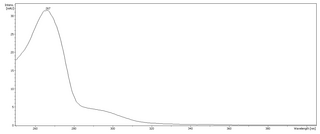
Gallic acid (also known as 3,4,5-trihydroxybenzoic acid) is a trihydroxybenzoic acid with the formula C6H2(OH)3CO2H. It is classified as a phenolic acid. It is found in gallnuts, sumac, witch hazel, tea leaves, oak bark, and other plants. It is a white solid, although samples are typically brown owing to partial oxidation. Salts and esters of gallic acid are termed "gallates".

Phloroglucinol is an organic compound with the formula C6H3(OH)3. It is a colorless solid. It is used in the synthesis of pharmaceuticals and explosives. Phloroglucinol is one of three isomeric benzenetriols. The other two isomers are hydroxyquinol (1,2,4-benzenetriol) and pyrogallol (1,2,3-benzenetriol). Phloroglucinol, and its benzenetriol isomers, are still defined as "phenols" according to the IUPAC official nomenclature rules of chemical compounds. Many such monophenolics are often termed polyphenols.
In enzymology, a trans-aconitate 3-methyltransferase is an enzyme that catalyzes the chemical reaction
In enzymology, a phloroglucinol reductase (EC 1.3.1.57) is an enzyme that catalyzes the chemical reaction
In enzymology, a mannitol dehydrogenase (cytochrome) (EC 1.1.2.2) is an enzyme that catalyzes the chemical reaction
In enzymology, a 3,4-dihydroxy-9,10-secoandrosta-1,3,5(10)-triene-9,17-dione 4,5-dioxygenase (EC 1.13.11.25) is an enzyme that catalyzes the chemical reaction
In enzymology, a pyrogallol 1,2-oxygenase (EC 1.13.11.35) is an enzyme that catalyzes the chemical reaction
In enzymology, a 2-hydroxy-1,4-benzoquinone reductase (EC 1.6.5.7) is an enzyme that catalyzes the chemical reaction

In enzymology, a precorrin-8X methylmutase is an enzyme that catalyzes the chemical reaction
In enzymology, a phloretin hydrolase (EC 3.7.1.4) is an enzyme that catalyzes the chemical reaction
The enzyme gallate decarboxylase (EC 4.1.1.59) catalyzes the chemical reaction
The enzyme 2-methylcitrate dehydratase (EC 4.2.1.79) catalyzes the chemical reaction
In enzymology, a hydroxydechloroatrazine ethylaminohydrolase (EC 3.5.99.3) is an enzyme that catalyzes the chemical reaction
In enzymology, a 2-methylcitrate synthase (EC 2.3.3.5) is an enzyme that catalyzes the chemical reaction
Decylcitrate synthase (EC 2.3.3.2) is an enzyme that catalyzes the chemical reaction in enzymology.

1,3,5-Trinitrobenzene is an organic compound with the formula C6H3(NO2)3. It is one of three trinitrated benzene-derivatives. A pale yellow solid, the compound is highly explosive.

The trihydroxybenzenes (or benzenetriols) are organic compounds with the formula C6H3(OH)3. Also classified as polyphenols, they feature three hydroxyl groups substituted onto a benzene ring. They are white solids with modest solubility in water.
Pelobacter acidigallici is the type species in the bacterial genus Pelobacter.

1,2,3,5-Tetrahydroxybenzene is a benzenetetrol.

2,4,6-Trinitrobenzoic acid (TNBA) is an organic compound with the formula (O2N)3C6H2CO2H. It is a high explosive nitrated derivative of benzoic acid.







